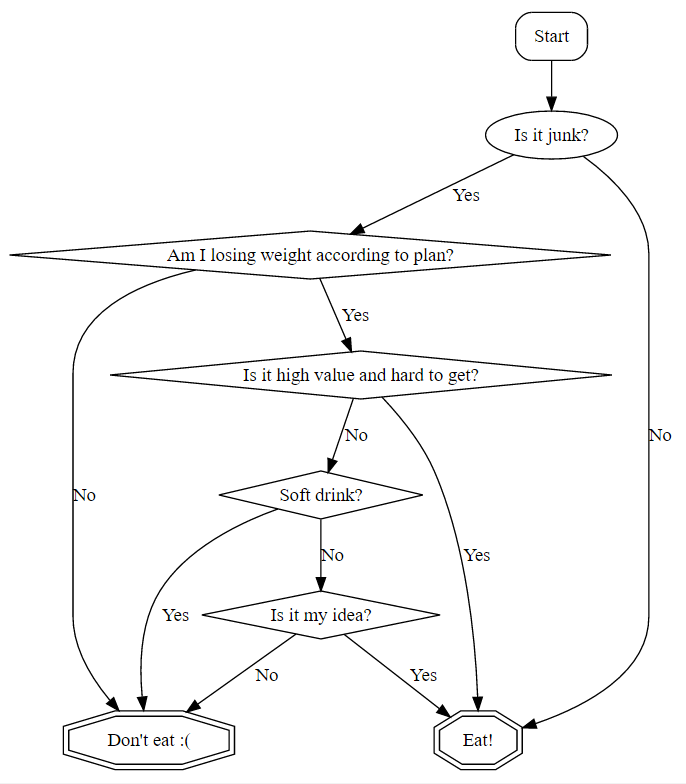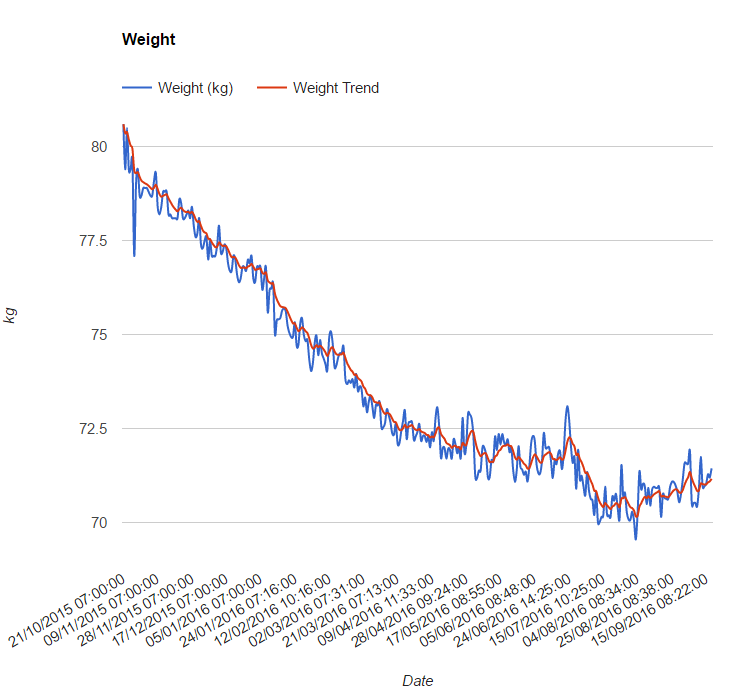The Chubby Programmer Diet Part III - Eating
This is Part III of a series of posts. Other posts in this series:
- Part I - Exercise
- Part II - Feedback
- Part III - Eating (you are here!)
Start with a Goal
We need to start with the end in mind. We are dieting to lose weight, so we need to decide on a target weight and a target date. I suggest avoiding “weight loss sprints” and trying to improve slowly over time. For my weight loss goal, I wanted to weigh 72kg which meant a loss of 8.6kg (from a start weight of 80.6kg). I gave myself 8 months for this goal. This is roughly 1kg/month. It’s possible to lose weight at greater speeds, but it’s also very likely to fail and not be able to catch up, if you set a faster weight loss expectation. A slow pace means you can fail and still get back up on track instead of giving up.
Remember we are keeping track of our measurements?
My trends are automatically calculated and I can just take a quick look at my main sheet and if everything is green - I’m good to go.
It’s important to always know if you are on the right track. Each day, you’ll need to look at your weight and body fat trends and see if you are keeping up with the pace you set as a goal. Every day, your trend goals are slightly lower, according to your pace.
Diets are FOREVER
When I was formulating my current diet I had one major goal written in huge neon-light letters: the only worthwhile diet I can have is one that I can keep forever. I don’t want “crash” diets, nor do I want a “satisfying” diet where I get to be full, but still abstain from foods I like. Any diet that forbids a certain item completely (or close) is off the table.
Yes, carbs are bad. Or maybe fats, or whatever. But I like French fries and pizza and ice cream and souffle (with ice cream) and coffee and chocolate croissants and bacon and ice cream and ceaser salads (with bacon) and lasanga and scrambled eggs (with bacon) and blue cheese and ice cream and cereal and affogato (that’s espresso with ice cream) and… Okay, I stopped drooling.
There is no way in hell I’m giving up any of that. Any diet which forbids me from having something I really like is doomed to fail as I slowly crack under the pressure. Let’s start being formal, shall we?
Rule #1: No food is forbidden.
Obviously we need more rules. So if I can eat whatever I want, I should probably at least not eat it all the time, right? My problem is mostly with sweets and desserts, but yours might be with Nachos or pizza. Let’s collectively refer to these “bad foods” as “junk”. The idea here is that you know what’s bad for you. It’s the application of this knowledge that is missing.
Rule #2: Only eat “junk” if it’s worth it.
I know, I know - this is really vague, so let’s refine it. Left to my own devices, I’ll eat sweets all-day everyday:
- Chocolate croissant with my morning coffee
- Soft drinks all day and with meals
- Chocolate from co-workers who’ve been abroad (CIMC - “chocolates in my cubic”)
- Birthday cakes! Promotion cakes! Thursday cakes! When you work at a big office, there’s always an occasion for cake!
- Dessert when going out to a restaurant
- Ice cream after supper with my wife
etc., etc.
How do you know if a sweet is worth it, though? My way of handling this overload of sweets is to use several heuristics. First, we’ll identify low-value “junk” that we consume a lot, but has really low cost / benefit ratio. For me, this means soft drinks.
Rule #2; Heuristic #1: Soft drinks are almost never worth it.
That’s it, plain and simple. My estimation is that this is one of the most effective parts of my diet. Simply drinking water with my food has not only allowed me to lose weight, but overall makes meals a better experience. Most of us wouldn’t even contemplate about eating souffle together with our main course, right? Drinking a highly-sugared drink distorts taste and make you hungrier, sooner. If you’re a serious addict and drink soft drinks throughout the day, I suggest that you start this withdrawal process by eliminating soft drinks while eating and see if you can take it from there.
Rule #2; Heuristic #2: Do not eat “junk” if it was not my idea.
This means that if I’m sitting at my desk and I suddenly think “man, I sure would like some chocolate right now”, I’ll go ahead and stuff some chocolate in my mouth right away. However, if someone else offers me sweets, I’ll always decline - e.g., birthday cakes, someone bringing chocolates from a trip abroad, someone bringing cookies for a coffee break, etc. Both fortunately and unfortunately, if you tell your co-workers about this rule, they might make an extra effort to “help” you by offering many sweets which you then are obligated to decline. Such friendship.
Alright, alright - I hear your discontent. What if it’s a really really good one? One of my co-workers once offered me a home-made maple cupcake with vanilla ice cream. You can bet your life I took one. Also, I usually don’t drink soft drinks, but once in a while, I can allow myself a soda, right? So, sometimes I’ll eat sweets even if they are “not allowed”:
Rule #2; Heuristic #3: High value hard-to-get “junk” is okay even if it was not my idea.
These 3 heuristics work great, but they are open to abuse - what if I have a “wrong” estimation of “high value junk” in that I allow myself to eat too many? What if I have too much intrinsic need for sweets? We need a zero-level heuristic that precedes the others. This is where we critically need feedback about our diet status. Since we know, day by day, whether we are on the right track to meet our weight loss goal, we can integrate this information into our eating decisions.
Rule #2; Heuristic #0: If you’re not meeting your weight loss goal, you are not allowed any “junk”.
This makes sure that the system is self-correcting. If we’ll eat lots of junk, we’ll have to eat healthy for enough days to catch up with our goal. If we use moderation, we can eat sweets every day! SWEETS. EVERY. DAY!
Putting it All Together

Conclusion
I tried several time to lose weight and to get in shape. The thing about diets and habit is to find what works for you. While I’m pretty sure my method should be applicable to many people, it’s pretty likely, like any other diet, that it might not work for you. My final two cents is that you should treat your body and behavior like any engineering problem - understand why an attempt failed and try to continuously improve your system.
After many years of just accepting that I’ll be chubby forever, I’m relieved to say that you can change, even if it doesn’t seem like it right now. Every failure has a lesson within it that you can use to further improve your method until you’ll find something that works.
In conclusion, I leave you with this - a graph of my weight since I started working out, gathering feedback and eating systematically:

Follow me on Twitter and Facebook
Thanks to Hannan Aharonov, Yonatan Nakar and Shachar Ohana for reading drafts of this.
